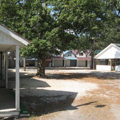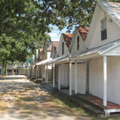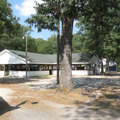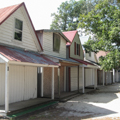Lower Delmarva was a center of early Methodism—21 percent of its adults were Methodist by 1810—and western Sussex County still has many rural churches. A survey in 1976 found two score of them in a twenty-mile radius of Laurel, mostly Methodist. Camp meetings were widespread, too, this being a favorite recruiting device. Historically there were around forty on the peninsula, including at least fifteen in Sussex County, the first of which was Zoar Camp between Millsboro and Harbeson, about eighty-five years old when it closed in 1919.
At all the camps, tents of brushwood or, more elaborately, frame cottages (also called tents) encircled the preaching arena or tabernacle, where the itinerant preacher hoarsely harangued a sweat-drenched crowd. Illumination was provided by burning “lightwood knots” of heart pine. Food was standard: fried chicken, lima beans, sugar corn, and watermelon. The automobile greatly changed camp meetings, making their crowds more transient. Electric lights soon illuminated the camps, and according to some accounts, young people seemed more interested in flirting than in expressing religious fervor.
Established in 1890, Antioch Camp Meeting on Clayton Street, near Frankford (known as “Big Camp” or “Frankford Camp”) served African Americans. The WPA Delaware Guide gives a lively account of the place before its destruction in a fire in 1943 and its subsequent rebuilding. Delmarva Camp, two miles north of Laurel (Cottage Circle Rd., off Camp Rd.), was founded in 1879 and was Delaware's largest, with some fifty frame tents in a circle around its tabernacle at the time of its abandonment in 1987. It is said that four camps survive in the state today, including Carey's and Antioch.
References
Works Progress Administration. Guide to Delaware: The First State. San Antonio, TX: Trinity University Press, 2014.
Writing Credits
If SAH Archipedia has been useful to you, please consider supporting it.
SAH Archipedia tells the story of the United States through its buildings, landscapes, and cities. This freely available resource empowers the public with authoritative knowledge that deepens their understanding and appreciation of the built environment. But the Society of Architectural Historians, which created SAH Archipedia with University of Virginia Press, needs your support to maintain the high-caliber research, writing, photography, cartography, editing, design, and programming that make SAH Archipedia a trusted online resource available to all who value the history of place, heritage tourism, and learning.






